Buyer's Guide - Entry Level to Mid-Range, March 2005
by Jarred Walton on March 15, 2005 1:30 PM EST- Posted in
- Guides
Video Cards
Assuming that you haven't selected one of the alternative motherboards with integrated graphics - or that you're looking for improved graphics performance - we have two different options. The socket 754 platform is currently AGP-only, although perhaps we'll see some PCIe boards using the nForce4 or a similar chipset in the future. The 939 and Intel platforms, on the other hand, are PCIe-only. (You could get a 939 AGP motherboard as well, of course.) The graphics recommendations will be different for each platform out of necessity, although we will try to keep price/performance as close as possible.AGP Graphics Recommendation:MSI Radeon 9550 128MB DDR 128-bit, 250/400 GPU/RAM clock (bulk/OEM)
Price: $67 shipped
For basic 3D graphics, the Radeon 9550 offers DirectX 9 support with enough performance to run most games that are two or three years old, and perhaps even more recent titles - at reduced quality levels. This is certainly no gamer card, but it does meet the minimum DX9 hardware requirement for the next version of Windows (Longhorn with eye candy enabled), and it will allow you to run either DVI or VGA displays along with providing TV-out support. There isn't a whole lot to differentiate the 9550 cards from one another, as they all run at similar clock speeds. We prefer the fanless varieties, of course, as they won't add any noise pollution to the room. If you can find some other brand for less money, it should be okay.
If you want more from your graphics, consider the GeForce 6200 AGP, 6600 AGP, and 6600GT AGP as the next three upgrades in order of performance. Their prices are around $100, $150, and $200 respectively, so you pay a lot more for the added performance. The Radeon 9600 (without the SE) is also a decent alternative that will only cost an extra $15. It's basically the same as the 9550 but with a faster core clockspeed (325MHz vs. 250MHz). For the price, we'd definitely stay away from the SE 9550 and 9600 cards.
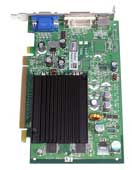 |
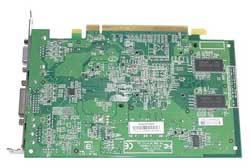 |
| Click images to enlarge. | |
PCIe Graphics Recommendation: Leadtek GeForce 6200TC 64-bit, 64MB (256 shared) PCIe with 350 MHz core
Price: $71 shipped
If you missed our article on the new 6200 TurboCache cards from NVIDIA, now would be a good time to check it out. These are once again budget parts, but they manage to reduce price in an interesting way. With the added bandwidth of the PCI Express bus, the amount of graphics RAM on the cards can be reduced and system RAM can be used instead, all without seriously degrading performance. 16MB and 32MB versions can utilize up to 128MB of system RAM, and 64MB versions can use up to 256MB of system RAM. As with the 9550, the total performance level is still relatively low, but the 6200TC-32 is generally slightly faster than the 9600SE and X300SE while the 6200TC-64 is faster than the 9600/X300.
 |
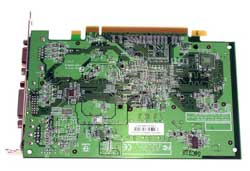 |
| Click images to enlarge. (Sample images of 16MB 16-bit 6200TC.) |
|
The TurboCache cards are available with either 32-bit or 64-bit memory interfaces, with core clock speeds ranging between 300 MHz and 350 MHz. The best price/performance is the 32MB 64-bit version, which is only slightly more expensive than the 16MB version. Look closely at what is being sold, however, as not all manufacturers or resellers are entirely clear on the specifications of the product being sold. If you can find some good pictures of the card, the presence of four RAM chips - two on each side - indicates that the card is a 64MB, 64-bit version. Two chips means that it's the 32MB, 32-bit model, and a single chip indicates that it's the low-end 16MB, 32-bit model. The full 128MB cards with 128-bit interfaces will have eight chips. To help you understand the differences, we have included two shots of the 6200TC-64 Leadtek card (front and back views) above. Compare that with the following images of a 6200TC-16 Leadtek card, and you can see the missing RAM chips.
PCIe Graphics Alternative:Leadtek GeForce 6600 128-bit, 128MB PCIe 300/550 MHz GPU/RAM
Price: $109 shipped
The full 6200 with 128-bit memory interface is the best of the "value" graphics chips, but with a price hovering just over $ 100, it's a pretty big jump. The better value at that range - at least for PCI Express - is to go with the 6600 chipset. It's supposed to be a "mid-range" part, and MSRP was initially $150, but the price has dropped quite a bit now. As most graphics chips are bandwidth limited with these cards, the jump from a 64-bit interface to a 128-bit interface improves performance quite a lot, particularly as resolutions increase. (If you're going with an AGP configuration, 6600 cards cost quite a bit more, so the 6200 128-bit is the better pick.) Overall performance of the 128-bit cards is generally better than the 9600 Pro cards of previous Guides, although not by a huge margin.
It is interesting to note that the current street prices on all the 6200 cards are quite a bit lower than the original estimates that we received from NVIDIA. The upgrade from the 16MB to 32MB cards is virtually free, with even the 64MB cards costing less than the original 6200 128MB cards. That's a good thing in our book, especially considering that the original 128-bit 6200 card is still the fastest of the bunch. For further performance increases, you'll need to look to the 6600 and 6600GT cards, just like on the AGP platform. If the X800 cards from ATI start to hit the $199 MSRP, that would also be a great option, albeit firmly in the mid-range price segment.
Update: Thanks to the reader comments for reminding us that the 9550 128-bit is a better choice than the 9600SE. The decreased GPU speed is typically less important than the increased memory bandwidth at this price point. They also pointed out the price drop on the 6600 PCIe cards, making them a better selection than the 6200 as an alternative. However, we still like the Gigabyte 6200 card initially listed as the alternative recommendation due to the inclusion of component output. If gaming isn't a concern but component output is, you might want to go with that instead of the 6600.


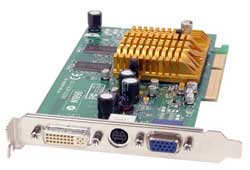
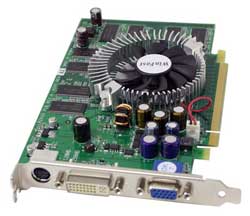








59 Comments
View All Comments
LoneWolf15 - Wednesday, March 16, 2005 - link
Note on the Hitachi hard disk drives:Hitachi is the ONLY major company that does not allow advance-exchange RMA of their hard disks. To me, this is huge when looking at a hard disk. Western Digital, Seagate, and Maxtor all have advanced exchange. After the nightmares I have had with IBM and Hitachi technical support, I could not in all honesty recommend them in a system. Personally, I can't afford that kind of downtime, having an advance replacement makes it easier to try and recover data from a crashed drive if necessary, and you aren't waiting in limbo while someone receives your defective drive, checks it in, diagnoses it bad, then sends you out a replacement, also placing you at the mercy of their stock-on-hand or whomever they choose to ship to you the replacement drive.
neologan - Wednesday, March 16, 2005 - link
There's another buyers guide at http://www.pureoverclock.com/review.php?id=9 but it doesn't choose its recommedations due to a really strict budget. Worth a read though i guess.JarredWalton - Wednesday, March 16, 2005 - link
26 - Thanks. Identity crisis indeed! I was originally looking at upgraded S754 instead of S939, but decided against it. :)As a side note, RAM prices have suddenly taken a massive cut. The PDP 2-3-2-5 is now $20 less than last week, and it's about $50 less than a couple months ago. Heck, you can even get 1GB (2x512) of Corsair CL2.5 for under $100 now - again, $50 less than last Guide!
chrisd154 - Wednesday, March 16, 2005 - link
"Socket 754 Alternative Motherboard: Chaintech VNF4 Socket 939""Socket 754 CPU: AMD Athlon 64 1.8 GHz 512KB L2 90nm socket 939"
Your socket 754 motherboard and cpu are having a bit of an identity crisis (i.e theyre 939). You might want to correct that mate.
JarredWalton - Wednesday, March 16, 2005 - link
24 - you want benchmarks of the speakers? Sorry, that's *way* beyond the scope of this Guide. Speakers costing $60 or less aren't being purchased primarily for their quality; they're being selected for price.If you mean benchmarks in general, that's something that would be great to have but not practical to do. Our various hardware reviews are meant to address the theory of what makes a good component/computer. For many of the parts in a budget system, price is a bigger factor than the final performance or quality. Sure, we'd like to have both, but the truth is you're not going to get SLI in a budget system. We do not have all of the parts available in one location for testing, and some of the parts may not even be in AnandTech's possession [anymore]. This is especially true of entry-level Guides, as many of the parts were new a year or more in the past
If you'd like specific information or you have a specific question, feel free to email me.
crimson117 - Wednesday, March 16, 2005 - link
I'd appreciate if you could add some benchmarks to compare "beeps and boops" quality. This guide is pretty much worthless without them.JarredWalton - Wednesday, March 16, 2005 - link
The MSI uATX is the only ATI Xpress 200 board currently available, and it's basically the same price as the Chaintech. Given that it's still pretty new, I'm a little hesitant to go with that over the "proven" nF4. Oh, and there are *no* overclocking options on the MSI board right now. Is that a BIOS problem or a chipset problem? I don't know. If you really like ATI or if you want a uATX form factor, it's definitely an option.kmmatney - Tuesday, March 15, 2005 - link
I'd consider the MSI ATI Radeon XPRESS 200 motherboard board for a budget system as well. From reviews I've read, using the on-board video doesn't seem to degrade overall 2D performance.Pair it with an Athlon 64 3000+ winchester for $235. A decent system for the non or light gamer, and you have the option of upgrading the video later. Too bad there aren't any budget 939 cpus.
JarredWalton - Tuesday, March 15, 2005 - link
I haven't had issues with the Chaintech, but that's only one person's experience with a specific RAM/GPU setup. The documentation is pretty lacking, but other than that it works well. Are you speaking from personal experience, and if so, what was the exact configuration (RAM, CPU, PSU, etc.)? It works well in the following configuration, although I had to manually set the RAM timings:Athlon64 3500+
Chaintech nForce4 VNF4
ATI X800 XL 256MB PCIe
1GB (2x512) Corsair DDR400 CAS2.5
Antec True430 PSU
NEC ND-3520A DVD±RW
WD 200GB SATA
SB Audigy 2 ZS
As for the DVD+RW, why save $20 when there won't be anything faster than a 16X burner, and the ability to backup 4.5GB of data rather than 700MB can come in handy? (And if that sounds like too much data, consider that a lot of people take digital pictures these days. A few hundred high quality images will fill a CD.) I mentioned the possibility to downgrade the optical drive, but I'm not going to recommend it.
mostlyprudent - Tuesday, March 15, 2005 - link
Are you serious ... recommending a motherboard with compatability and stability problems just to save $10? And why put a DVD-RW drive in a budget system? Optical drives are quite simple to upgrade down the road. You would have to be crazy to skimp on the quality of the motherboard to fit in an upgraded optical drive. You can get a DVD-ROM/CD-RW combo drive for about $20 less than the NEC drive you suggest. I would take that $20 dollars and invest it in a stable/reliable motherboard -- there is nothing worse than a finiky mobo as far as I'm concerned.